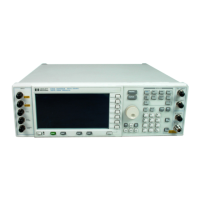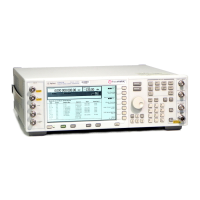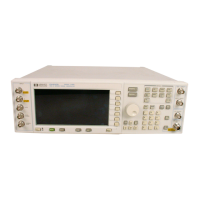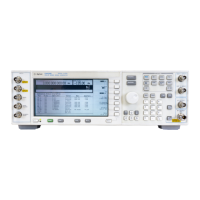
Do you have a question about the Agilent Technologies E4400B and is the answer not in the manual?
| Power Resolution | 0.1 dB |
|---|---|
| Harmonics | <-30 dBc |
| Non-harmonic Spurious | <-60 dBc |
| Display | LCD |
| Output Power | -136 to +13 dBm |
| Modulation Types | AM, FM, Phase, Pulse |
| Power Requirements | 100 to 240 VAC, 50 to 60 Hz |
| Amplitude Accuracy | +/- 1.0 dB |
Procedures for properly installing the signal generator, including shipment check and handle installation.
Daily functional check to verify proper operation and identify any errors.
Information on obtaining the latest news, product support, and application literature.
Step-by-step guide to setting the RF frequency and output power level.
Procedure to generate an amplitude-modulated signal with specific carrier frequency, power, depth, and rate.
Procedure to generate a frequency-modulated signal with specific carrier frequency, power, deviation, and rate.
Two methods to set up the signal generator to sweep defined sets of points.
Learn how to save instrument settings to a memory register and recall them.
How to enable both hardware and software options for added capabilities.
List of symptoms and possible solutions for unexpected behavior.
Instructions on how to return the signal generator for servicing.
Description of the keys, connectors, and display layout of the front panel.
Explanation of different areas and indicators on the signal generator's display.
Description of the connectors and layout of the rear panel.
Details on Amplitude Modulation (AM) settings and softkeys.
Reference for Amplitude (Ampl) settings and related softkeys.
Details on Frequency Modulation (FM) settings and softkeys.
Reference for Frequency settings and related softkeys.
Details on I/Q modulation settings and softkeys.
Reference for Low Frequency (LF) Output settings and related softkeys.
Details on Phase Modulation (ΦM) settings and softkeys.
How to turn the signal generator's power on or to standby mode.
How to set the signal generator to a known state (factory or user-defined).
Details on Pulse modulation settings and softkeys.
How to recall saved instrument states from memory registers.
Toggles the RF signal on and off at the RF OUTPUT connector.
How to save the current instrument state to memory registers and sequences.
Defining series of points for frequency, amplitude, and dwell time sweeps.
How to trigger specified events or series of events, including sweeps and modulations.
Access to system settings, memory catalog, and diagnostic information.
Description of the different types of memory used in the signal generator.
How to view, copy, rename, and delete stored files using the memory catalog.
Explains the meaning of CAUTION and WARNING notes used in the manual.
Explains the various safety, compliance, and operational markings on the instrument.
General safety guidelines and precautions to prevent electrical shock and product damage.
Declares product compliance with IEC Publication 1010 and safety requirements.
Information on obtaining product maintenance agreements and customer assistance.
Agilent Technologies certifies product specifications and calibration traceability.
Formal declaration of conformity to EMC and safety standards.
Declares conformance with German regulations on noise declaration for machines.











